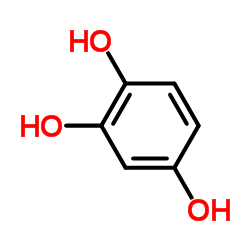1,2,4-Trihydroxybenzene

1,2,4-Trihydroxybenzene structure
|
Common Name | 1,2,4-Trihydroxybenzene | ||
|---|---|---|---|---|
| CAS Number | 533-73-3 | Molecular Weight | 126.110 | |
| Density | 1.5±0.1 g/cm3 | Boiling Point | 334.5±12.0 °C at 760 mmHg | |
| Molecular Formula | C6H6O3 | Melting Point | 140 °C (subl.)(lit.) | |
| MSDS | Chinese USA | Flash Point | 176.9±14.2 °C | |
| Symbol |


GHS05, GHS07 |
Signal Word | Danger | |
|
A convenient screening method to differentiate phenolic skin whitening tyrosinase inhibitors from leukoderma-inducing phenols.
J. Dermatol. Sci. 80 , 18-24, (2015) Tyrosinase is able to oxidize a great number of phenols and catechols to form ortho-quinones. Ortho-quinones are highly reactive compounds that exert cytotoxicity through binding with thiol enzymes and the production of reactive oxygen species. Certain phenol... |
|
|
Degradation of sulfonamide antibiotics by Microbacterium sp. strain BR1 - elucidating the downstream pathway.
New Biotechnology 32 , 710-5, (2015) Microbacterium sp. strain BR1 is among the first bacterial isolates which were proven to degrade sulfonamide antibiotics. The degradation is initiated by an ipso-substitution, initiating the decay of the molecule into sulfur dioxide, the substrate specific he... |
|
|
The TetR-type transcriptional repressor RolR from Corynebacterium glutamicum regulates resorcinol catabolism by binding to a unique operator, rolO.
Appl. Environ. Microbiol. 78(17) , 6009-16, (2012) The rol (designated for resorcinol) gene cluster rolRHMD is involved in resorcinol catabolism in Corynebacterium glutamicum, and RolR is the TetR-type regulator. In this study, we investigated how RolR regulated the transcription of the rol genes in C. glutam... |
|
|
Phenolic metabolites of benzene induced caspase-dependent cytotoxicities to K562 cells accompanied with decrease in cell surface sialic acids.
Environ. Toxicol. 29(12) , 1437-51, (2014) Benzene-induced erythropoietic depression has been proposed to be due to the production of toxic metabolites. Presently, the cytotoxicities of benzene metabolites, including phenol, catechol, hydroquinone, and 1,2,4-benzenetriol, to erythroid progenitor-like ... |
|
|
Solvent effect on pathways and mechanisms for D-fructose conversion to 5-hydroxymethyl-2-furaldehyde: in situ 13C NMR study.
J. Phys. Chem. A 117(10) , 2102-13, (2013) Noncatalytic reactions of D-fructose were kinetically investigated in dimethylsulfoxide (DMSO), water, and methanol as a function of time at temperatures of 30-150 °C by applying in situ (13)C NMR spectroscopy. The products were quantitatively analyzed with d... |
|
|
Effects of co-exposure to extremely low frequency (ELF) magnetic fields and benzene or benzene metabolites determined in vitro by the alkaline comet assay.
Toxicol. Lett. 157(2) , 119-28, (2005) In the present study, we investigated in vitro the possible genotoxic and/or co-genotoxic activity of 50 Hz (power frequency) magnetic fields (MF) by using the alkaline single-cell microgel-electrophoresis (comet) assay. Sets of experiments were performed to ... |
|
|
Nonrandom aneuploidy of chromosomes 1, 5, 6, 7, 8, 9, 11, 12, and 21 induced by the benzene metabolites hydroquinone and benzenetriol.
Environ. Mol. Mutagen. 45(4) , 388-96, (2005) The loss and gain of whole chromosomes (aneuploidy) is common in the development of leukemia and other cancers. In acute myeloid leukemia, the loss (monosomy) of chromosomes 5 and 7 and the gain (trisomy) of chromosome 8 are common clonal chromosomal abnormal... |
|
|
para-Nitrophenol 4-monooxygenase and hydroxyquinol 1,2-dioxygenase catalyze sequential transformation of 4-nitrocatechol in Pseudomonas sp. strain WBC-3.
Biodegradation 21(6) , 915-21, (2010) Pseudomonas sp. strain WBC-3 utilizes para-nitrophenol (PNP) as a sole source of carbon, nitrogen and energy. PnpA (PNP 4-monooxygenase) and PnpB (para-benzoquinone reductase) were shown to be involved in the initial steps of PNP catabolism via hydroquinone. ... |
|
|
Identification and characterization of another 4-nitrophenol degradation gene cluster,nps, inRhodococcussp. strain PN1
J. Biosci. Bioeng. 111(6) , 687-94, (2011) 4-Nitrophenol (4-NP) is a toxic compound formed in soil by the hydrolysis of organophosphorous pesticides, such as parathion. We previously reported the presence of the 4-NP degradation gene cluster ( nphRA1A2) in Rhodococcus sp. strain PN1, which encodes a t... |
|
|
Dearomatizing benzene ring reductases.
J. Mol. Microbiol. Biotechnol. 10(2-4) , 132-42, (2005) The high resonance energy of the benzene ring is responsible for the relative resistance of aromatic compounds to biodegradation. Nevertheless, bacteria from nearly all physiological groups have been isolated which utilize aromatic growth substrates as the so... |